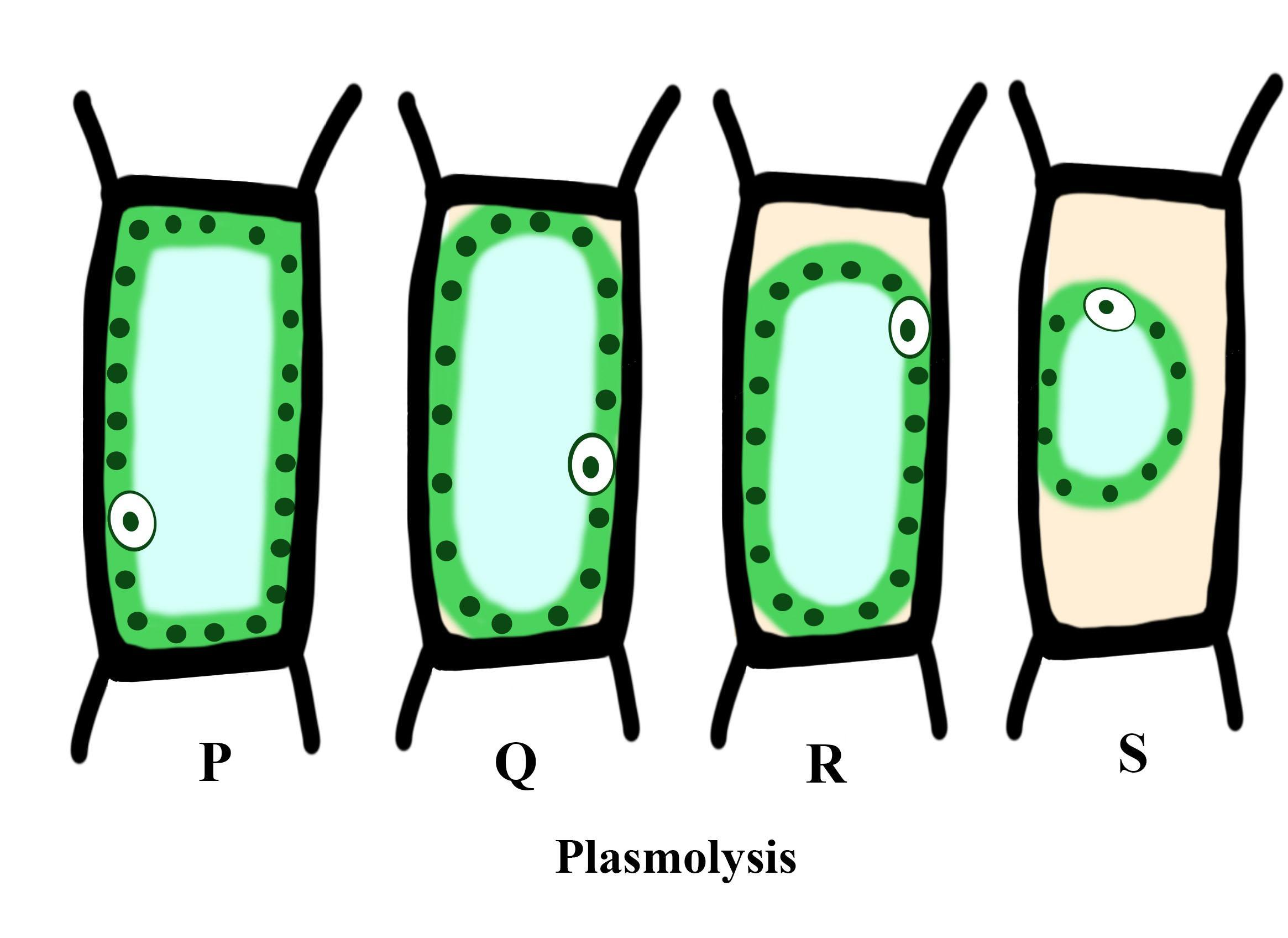
In the given diagram, which is the initial condition of plasmolysis:

(a) P
(b) Q
(c) R
(d) S

Answer
484.8k+ views
Hint: In general, the term Plasmolysis was derived from the Latin and Greek term plasma, meaning the mould and the meaning loosening arises from the word lusis. The initial or incipient plasmolysis process is the process in which the water begins to exit the cell.
Complete step by step answer:
Plasmolysis is defined as the process of contraction or shrinkage of a plant cell's protoplasm and is caused by water loss in the cell. Plasmolysis is an explanation of the effects of osmosis and is rarely observed in nature.
The cell loses water and only loses its turgidity in the initial plasmolysis state. The shape does not shift much, just the membrane of the cell stops touching the wall of the cell. This stage is represented by the picture Q. A turgid cell is represented by Image P. The middle and final stages of plasmolysis are represented by images R and S respectively.

So, the correct answer is, ‘Q’.
Additional information: Plasmolysis Stages are as follows:
In three separate steps, the full process of plasmolysis takes place.
- Incipient plasmolysis: This is the initial stage of plasmolysis, during which water begins to leak out of the cell; initially, the volume of the cell shrinks, and the cell wall becomes detectable.
- Evident plasmolysis: It is the next stage of plasmolysis during which the cell wall has reached its contraction limit and the cytoplasm is detached from the spherical form of the cell wall.
- Final plasmolysis: the third and final step of plasmolysis during which the cytoplasm is completely free from the cell wall and stays in the center of the cell.
Note: In a hypertonic solution, plasmolysis is the phase in which cells lose water. If the cell is in a hypotonic solution that results in a lower external osmotic pressure and a net flow of water into the cell, the reverse process, deplasmolysis or cytolysis, can occur. It is possible to determine the tonicity of the cell's environment by studying plasmolysis and deplasmolysis, as well as the rate of solvent molecules crossing the cellular membrane.
Complete step by step answer:
Plasmolysis is defined as the process of contraction or shrinkage of a plant cell's protoplasm and is caused by water loss in the cell. Plasmolysis is an explanation of the effects of osmosis and is rarely observed in nature.
The cell loses water and only loses its turgidity in the initial plasmolysis state. The shape does not shift much, just the membrane of the cell stops touching the wall of the cell. This stage is represented by the picture Q. A turgid cell is represented by Image P. The middle and final stages of plasmolysis are represented by images R and S respectively.

So, the correct answer is, ‘Q’.
Additional information: Plasmolysis Stages are as follows:
In three separate steps, the full process of plasmolysis takes place.
- Incipient plasmolysis: This is the initial stage of plasmolysis, during which water begins to leak out of the cell; initially, the volume of the cell shrinks, and the cell wall becomes detectable.
- Evident plasmolysis: It is the next stage of plasmolysis during which the cell wall has reached its contraction limit and the cytoplasm is detached from the spherical form of the cell wall.
- Final plasmolysis: the third and final step of plasmolysis during which the cytoplasm is completely free from the cell wall and stays in the center of the cell.
Note: In a hypertonic solution, plasmolysis is the phase in which cells lose water. If the cell is in a hypotonic solution that results in a lower external osmotic pressure and a net flow of water into the cell, the reverse process, deplasmolysis or cytolysis, can occur. It is possible to determine the tonicity of the cell's environment by studying plasmolysis and deplasmolysis, as well as the rate of solvent molecules crossing the cellular membrane.
Latest Vedantu courses for you
Grade 9 | CBSE | SCHOOL | English
Vedantu 9 CBSE Pro Course - (2025-26)
School Full course for CBSE students
₹35,000 per year
Recently Updated Pages
Express the following as a fraction and simplify a class 7 maths CBSE

The length and width of a rectangle are in ratio of class 7 maths CBSE

The ratio of the income to the expenditure of a family class 7 maths CBSE

How do you write 025 million in scientific notatio class 7 maths CBSE

How do you convert 295 meters per second to kilometers class 7 maths CBSE

Write the following in Roman numerals 25819 class 7 maths CBSE

Trending doubts
State and prove Bernoullis theorem class 11 physics CBSE

What are Quantum numbers Explain the quantum number class 11 chemistry CBSE

Write the differences between monocot plants and dicot class 11 biology CBSE

1 ton equals to A 100 kg B 1000 kg C 10 kg D 10000 class 11 physics CBSE

State the laws of reflection of light

One Metric ton is equal to kg A 10000 B 1000 C 100 class 11 physics CBSE




